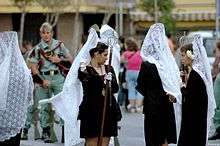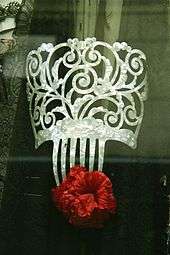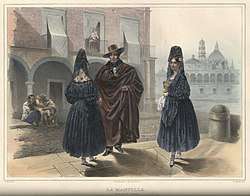Mantilla
A mantilla is a traditional Spanish lace or silk veil or shawl worn over the head and shoulders, often over a high comb called a peineta, popular with women in Spain.[1] It is also worn, without the peineta, by Eastern Orthodox women in Russia, often white, with the ends crossed over neck and draped over the opposite shoulder. The shape, design and use are different from an ordinary veil.

History
The lightweight ornamental mantilla came into use in the warmer regions of Spain towards the end of the 16th century, and ones made of lace became popular with women in the 17th and 18th centuries, being depicted in portraits by Diego Velázquez and Goya. In the 19th century, Queen Isabella II actively encouraged its use. The practice diminished after her abdication in 1870, and by 1900 the use of the mantilla became largely limited to formal occasions such as bullfights, Holy Week and weddings.
The speculation that it was originally worn by women of the Andalusia region of Spain, allegedly due to Muslim influences, is unsubstantiated. From the 16th century onwards, as Spaniards settled in Mexico, Central and South America, they brought the traditional cultural custom of wearing the mantilla with them.


_-_Fondo_Mar%C3%ADn-Kutxa_Fototeka.jpg)
In Spain, women still wear mantillas during Holy Week (the week leading to Easter), bullfights and weddings. Also a black mantilla is traditionally worn when a woman has an audience with the Pope and a white mantilla is appropriate for a church wedding, but can be worn at other ceremony occasions as well. In accordance with what is known as the privilège du blanc only the queen of Spain and selected other Catholic wives of Catholic sovereigns can wear a white mantilla during an audience with the Pope.
Peineta
A peineta, similar in appearance to a large comb, is used to hold up a mantilla. This ornamental comb, usually in tortoiseshell color, originated in the 19th century. It consists of a convex body and a set of prongs and is often used in conjunction with the mantilla. It adds the illusion of extra height to the wearer and also holds the hair in place when worn during weddings, processions and dances. It is a consistent element of some regional costumes of Valencia and Andalusia and it is also often found in costumes used in the Moorish and Gypsy influenced music and dance called Flamenco.
 Mexican women wearing the mantilla, painting by Carl Nebel, 1836
Mexican women wearing the mantilla, painting by Carl Nebel, 1836 Raquel Meller, Spanish singer and actress, 1910
Raquel Meller, Spanish singer and actress, 1910.jpg) Blond mantillina Twentieth century. Object of the permanent exhibition of the "Secà i Muntanya" room of the Valencian Museum of Ethnology - Photographs by Mateo Gamon.
Blond mantillina Twentieth century. Object of the permanent exhibition of the "Secà i Muntanya" room of the Valencian Museum of Ethnology - Photographs by Mateo Gamon.
See also
- Christian headcovering
- Easter bonnet
- Mob cap
References
- The American Heritage Dictionary of the English Language; 4th edition. 2000
External links
| Wikimedia Commons has media related to mantilla. |
| Look up mantilla in Wiktionary, the free dictionary. |